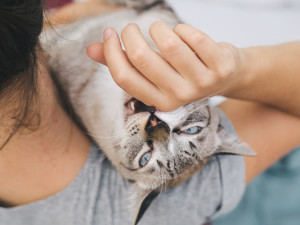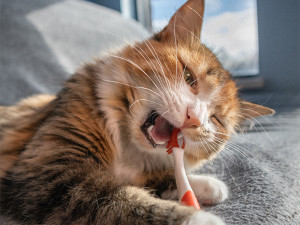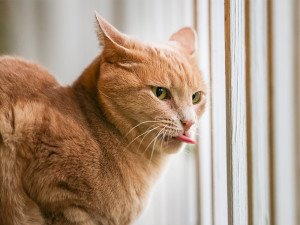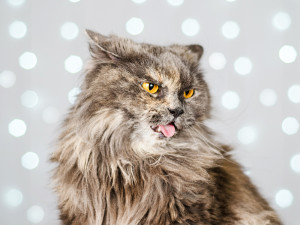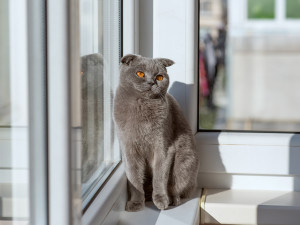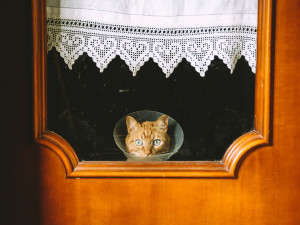What to Know About Runny Noses in Cats
Nasal discharge doesn’t sound cute, but you need to know what to look out for.

share article
Most of us can agree that kitten sneezes are pretty dang adorable. Like, come on: A tiny little kitten going achoo absolutely belongs on an early aughts-style poster that you bought at your Scholastic school fair (IYKYK). But it’s a little less adorable when those tiny sneezes become snotty messes. A cat with a runny nose is described as having nasal discharge (not so cute), but it’s important to know why they have it. There are a few reasons why cats can have nasal discharge. Here’s where some of this snot may be coming from.
Symptoms of Nasal Discharge Cats
Nasal discharge in cats varies in color and viscosity, depending on the cause. It can be watery or thick. It can be clear, opaque, yellowish, green, or bloody. Cats with runny noses often display sniffling, sneezingopens in a new tab, or nasal congestionopens in a new tab. They can also have red squinty eyes with similar discharge and may rub or paw at their face. Depending on the cause, cats with runny noses may also have decreased energy and a poor appetiteopens in a new tab.
Causes of Nasal Discharge Cats
There are a variety of reasons why a cat may develop nasal discharge. Some causes are minor and quickly resolve on their own, some are long-lasting, and others may require aggressive treatment.
Upper respiratory infections
Upper respiratory infections are extremely common in cats, especially cats in crowded shelters or similar environments. Most upper respiratory infections are caused by viruses, the most common being feline herpesvirus and feline calicivirus. Some infections have a bacterial component, with the common agents being Bordetella bronchiseptica and Chlamydia felis. Nasal discharge from upper respiratory infections often starts off clear or mucoid but with time may progress to being yellow or greenish.
Allergies
Cats can experience environmental allergiesopens in a new tab just like humansopens in a new tab. Cats with allergies will often develop clear, thin nasal discharge along with sneezing, itching, and irritated eyes.
Dental disease
Cats with severe dental disease opens in a new tabwill develop inflammation and infection below the gum line. With time, this nastiness can penetrate deeper into the nasal cavity resulting in mucoid or blood-tinged nasal discharge. Severe dental disease can also cause facial swelling, bad breath, and poor appetite. Many cats will stop eating due to the painopens in a new tab associated with chewing.
Foreign bodies
Curious cats can accidentally inhale small pieces of grass or other bits of foreign material that get stuck in their nasal cavities. Cats with nasal foreign bodies often paw at their faces, sneeze, gagopens in a new tab, and have runny noses. The nasal discharge tends to be one-sided (the side of the nostril that snorted the material) and can be mucoid or blood-tinged.
Fungal infection
Fungal spores, such as Aspergillus, can be inhaled from plant material or rotting food. Cats, especially those with weakened immune systems, can develop respiratory fungal infections that can cause nasal discharge or bloody noses.
Bloody noses
Cats can develop bloody noses from trauma or bleeding disorders. Bleeding disorders can develop from underlying auto-immune disease, canceropens in a new tab, or rat bait ingestion.
Tumors or growths
Polyps are benign growths that can occur in nasal cavities. Both polyps and cancerous growths can cause cats to have nasal discharge and loud nasal sounds.
Diagnosing Nasal Discharge in Cats
When investigating a cat’s runny nose, the veterinarian will take a complete history and perform a physical examination. Sedation may be recommended to allow a thorough oral exam, especially in cases of dental disease where a cat may not really feel like having fingers in their painful mouth. Vets prefer not to interact with cat teeth too much, anyway.
Blood work may be performed to evaluate the cat’s general health and gauge the risk of anesthesia in case additional procedures are recommended. Blood work can also provide a platelet count and clotting times to rule out an underlying bleeding disorder, which is important for cats with bloody noses. Imaging of the skull with radiographs or a CT scan is used to evaluate tooth roots, skull bones, and sinus cavities.
Sometimes vets will need to go directly to the source to get vital information, which means getting in a cat’s tiny nose. Cytology can look for cancerous cells, inflammatory cells, bacteria, or fungi in the nasal cavity. This may be performed by directly swabbing the nose or flushing the nasal cavity and collecting cells. A rhinoscopy is a procedure in which a small camera is passed into the nasal cavity to look for foreign material, tumors, abnormal tissue, or signs of infection. Removal of foreign material or a biopsy can oftentimes be accomplished at the same time. These procedures are typically performed under anesthesia.
Treatment for Nasal Discharge
Treatment for a cat’s runny nose depends on the underlying cause. Mild viral upper respiratory infections can often be treated with minimal supportive care, such as canned food (to entice appetite and increase water intakeopens in a new tab) and at-home nebulization. Nebulization can be performed by leaving a cat in a steamy bathroom for five to 10 minutes to loosen the mucus in the nose. Antibiotics may be prescribed to treat secondary bacterial infections.
Allergies can’t be cured, but environmental adjustments can lessen exposure to irritants. This may include eliminating potpourris, cigarette smoke, and dusty cat litter. Dental disease is treated with antibiotics, dental cleaning, and sometimes tooth extractions. Vets treat fungal infections with anti-fungal medications. Foreign bodies and polyps are removed under anesthesia. Cancerous tumors may be treated with any combination of surgery, radiation, or chemotherapy. Treatment for bleeding disorders depends on the underlying cause, but long-term medications are often required.
Any of these issues can result in a cat developing chronic rhinitis — inflammation of the lining of the nasal cavity. This is most common in cats that have runny noses from underlying viral infection. These chronic snufflers will have symptoms that wax and wane, sometimes indefinitely, and require long-term management and care.

Dr. Alycia Washington, DVM, MS
Alycia Washington, DVM, is a small animal emergency veterinarian based in North Carolina. She works as a relief veterinarianopens in a new tab and provides services to numerous emergency and specialty hospitals. Dr. Washington is also a children’s book author and freelance writer with a focus on veterinary medicine. She has a special fondness for turtles, honey bees, and penguins — none of which she treats. In her free time, Dr. Washington enjoys travel, good food, and good enough coffee.
Related articles
![Cat sticking its tongue out in motion]() opens in a new tab
opens in a new tabWhy Does My Cat Drool?
Dogs rule, cats drool. Like, that’s normal, right?
![grey and white cat with tongue sticking out]() opens in a new tab
opens in a new tabWhy Does My Cat Keep Throwing Up?
Here’s when you should worry.
![Uncomfortable looking gray cat sitting on a window sill]() opens in a new tab
opens in a new tabShould Your Cat Go to the ER?
Here are six good reasons to haul tail to the emergency room.
![cat with cone after vet visit]() opens in a new tab
opens in a new tabDoctor’s Orders: Cat Vet Visits Are Essential
Get thy cat to a vet, even if it’s a struggle to get them out the door.
![cat getting a vaccine at the vet]() opens in a new tab
opens in a new tabYep, Kittens Need Vaccines (Even Indoor Ones)
A vet gets the facts straight.
![Kitten sitting on a blanket]() opens in a new tab
opens in a new tab7 Steps to Keep Your New Kitten Happy and Healthy
With great cuteness comes great responsibility. A vet breaks down everything you need to know when you bring home a new kitten.

